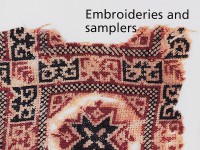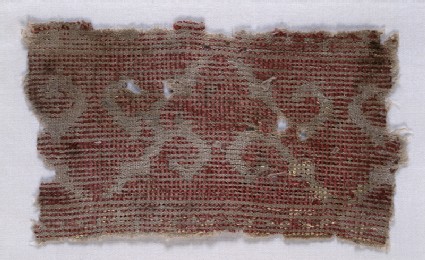Embroideries and Samplers from Islamic Egypt
A selection of 10th to 16th century embroideries from the Newberry collection at the Ashmolean by Marianne Ellis (published Oxford, 2001).

Publications online: 66 objects
- Reference URL
Actions
Textile fragment with tendrils
-
Literature notes
The detail is taken from part of a band of trefoils arranged alternately in upright and reversed positions. Most of the yellow silk stitching has perished, but enough of the red has survived for us to see the characteristic plaited effect produced by close counted herringbone stitch (also known as Greek stitch and classified under canvas work). The same effect is produced by long-armed cross stitch, but the method of working is different and results in lines of horizontal stitches on the reverse side instead of vertical ones made by long-armed cross stitch. The way in which close counted herringbone is worked is typical of one category of Mamluk embroidery and, if present on a textile, strongly suggests a Mamluk Egypt origin. During the 20th century, the method of working long-armed cross stitch changed, possibly because in stitch dictionaries the instructions implied that every row should be worked in the same direction with the long arm slanting stitches all facing the same way, so losing the plaited effect. Historically, long-armed cross stitch was worked continuously back and forth in succeeding rows, and its qualities as textural filling stitch were appreciated by later embroiderers in Azemmour (Morocco), and the Greek Islands, where it was used for embroidered furnishings to decorate homes. -
Details
- Associated place
-
Near East (place of creation)
- Material and technique
- linen, embroidered with red and remains of yellow silk
- Dimensions
-
12 x 7 cm (length x width)
along length/width 21 / 25 threads/cm (thread count)
ground fabric 0.04 cm (thread diameter)
additional fibre, embroidery 0.06 cm (thread diameter)
- Material index
-
organic › animal › animal product › silk
- Technique index
-
woven › plain woven,assembled › woven › plain woven,
- Object type index
- No. of items
- 1
- Credit line
- Presented by Professor Percy Newberry, 1941.
- Accession no.
- EA1993.153
-
Further reading
Ellis, Marianne, Embroideries and Samplers from Islamic Egypt (Oxford: Ashmolean Museum, in association with Greenville: Curious Works Press, 2001), no. 39 on p. 57, p. 82, illus. p. 57
Barnes, Ruth and Marianne Ellis, ‘The Newberry Collection of Islamic Embroideries’, 4 vols, 2001, Oxford, Ashmolean Museum, cat. p. 114 (vol. iv), illus. vol. iv p. 114
Location
-
- currently in research collection
Objects are sometimes moved to a different location. Our object location data is usually updated on a monthly basis. Contact the Jameel Study Centre if you are planning to visit the museum to see a particular object on display, or would like to arrange an appointment to see an object in our reserve collections.
Publications online
-

Embroideries and Samplers from Islamic Egypt
The detail is taken from part of a band of trefoils arranged alternately in upright and reversed positions. Most of the yellow silk stitching has perished, but enough of the red has survived for us to see the characteristic plaited effect produced by close counted herringbone stitch (also known as Greek stitch and classified under canvas work). The same effect is produced by long-armed cross stitch, but the method of working is different and results in lines of horizontal stitches on the reverse side instead of vertical ones made by long-armed cross stitch. The way in which close counted herringbone is worked is typical of one category of Mamluk embroidery and, if present on a textile, strongly suggests a Mamluk Egypt origin. During the 20th century, the method of working long-armed cross stitch changed, possibly because in stitch dictionaries the instructions implied that every row should be worked in the same direction with the long arm slanting stitches all facing the same way, so losing the plaited effect. Historically, long-armed cross stitch was worked continuously back and forth in succeeding rows, and its qualities as textural filling stitch were appreciated by later embroiderers in Azemmour (Morocco), and the Greek Islands, where it was used for embroidered furnishings to decorate homes. -

The Newberry Collection of Islamic Embroideries
A band of paired tendrils alternating in their direction. The tendrils have remains of yellow (undyed) silk embroidery, the background is pale red.
Notice
Object information may not accurately reflect the actual contents of the original publication, since our online objects contain current information held in our collections database. Click on 'buy this publication' to purchase printed versions of our online publications, where available, or contact the Jameel Study Centre to arrange access to books on our collections that are now out of print.
© 2013 University of Oxford - Ashmolean Museum

